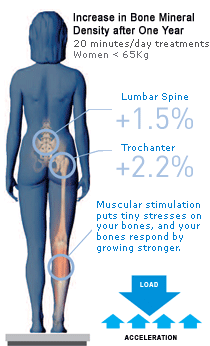Scientist gets vibes to build bones
Unnati Gandhi
From Tuesday's Globe and Mail
It looks like an oversized bathroom scale. It hardly feels like it's moving. And it's silent.
But it is what you cannot see, feel or hear that is making doctors, businessmen and astronauts giddy with glee.
The new device, using vibration therapy, is promising to help build bone mass in people with osteoporosis, children with cerebral palsy, and those hovering above Earth in zero gravity.
The sleek platform measures 50 centimetres by 81 cm. A person who stands on it for 20 minutes a day can build bone density an average of 2 per cent a year -- that's comparable to the results of drug therapy for osteoporosis, and equivalent to what someone with osteoporosis loses a year. If used in space, researchers say, the platform can help astronauts prevent the 2-per-cent bone loss they experience every month.
Inspired by the way bones are naturally stimulated by muscle fibres to grow and develop, bone bioengineer Clinton Rubin embarked on a scientific journey in 1981 to understand and mimic that process for people whose bones are rapidly thinning out, and who can't, or won't, take medication to treat the condition.
Twenty-five years later, he arrived at his destination.
"We've managed to make the mechanics of bone into a [device]," said Dr. Rubin, who is chair of the biomechanical engineering department of the State University of New York at Stony Brook. Dr. Rubin and the company manufacturing the platform, Juvent Inc. of
Osteoporosis, a skeletal disorder characterized by low bone density that predisposes a person to increased risk of fracture, affects one in four women older than 50 and one in eight men older than 50. An estimated 1.4 million Canadians suffer from it.
Dr. Rubin was intrigued by how little mechanical load the bone actually needs to react physiologically and build new mass. "[In our research], we kept loading it a little less and a little less, but it kept responding. We got the same response heavily loading the bone and just buzzing the bone for a longer period of time."
What came out of his quarter-century-long research was the Juvent 1000.
By sending small vibrations through the body -- moving about 50 micrometres (or the thickness of a few human hairs) up and down and repeating at a rate of 34 cycles per second -- the platform triggers musculoskeletal stimulations that naturally occur during common activities such as standing, maintaining balance and walking. The barely noticeable body twitches make the muscles around the hips and spinal cord contract, putting tiny stresses on the bone and resulting in bone-building activity. The body naturally sets off these twitches, but they slow down and aren't as strong with age. That's why osteoporosis afflicts so many seniors.
Because the vibrations from the platform are set to a frequency that is one-third that of gravity, the Juvent 1000 has been deemed safe by the U.S. Food and Drug Administration. Earlier this year, Health
But Dr. Rubin warns against look-a-like exercise machines that have recently been popping up in gyms, promising to bulk up muscle and pump out hormones -- even attracting the likes of Madonna and Claudia Schiffer.
The machines are set to similar, but much stronger, vibrating frequencies at four to 15 times that of gravity, and do not have the evidence to support the medical claims they make, he said.
"In essence, it's like jumping off a refrigerator 30 times a second," he said. "You'll see stress fractures, you'll see herniated discs, disruption of major organs, you'll see some nasty things happen. I think they're incredibly dangerous."
In its final research stages, the Juvent was tested on three different groups of people, including 48 women between 16 and 21 with low bone density at the Children's Hospital in
Currently, about 90 people in Texas are participating in a U.S. National Aeronautics and Space Administration bed-rest study to test how effective the platform will be in space, because a variation of it is being sent up to the International Space Station next year. By staying in bed for a prolonged period of time, researchers can simulate the effects of zero gravity on the bones. NASA has co-funded many of the research studies involving the Juvent.
The device was unveiled in
"You can take a pill and treat your bones, but two-thirds of the risk factor for failure of osteoporosis is falling and muscle strength," Dr. Rubin said. "The pill is only helping the other one-third of the risk, whereas [the platform] helps make your bones and muscles stronger."
While she agrees with the short-term benefits of using the platform, Suzanne Morin, an osteoporosis expert at the McGill University Health Centre in
"I understand that it is not dangerous and the vibration is tolerable, but there are still unanswered questions. Like, what happens if you stop using it? Do you lose the bone mineral density you gained?" Renée Newman, 58, has osteopenia (lower than normal bone mineral density).
She started using the platform about four months ago and has slowly been weaning herself off her medication.
"I would rather not have any drugs at all," the
Ms. Newman, author of Osteoporosis Prevention: A Proactive Approach to Strong Bones & Good Health, says standing on the platform for 20 minutes a day is having the same effect on her body as daily strength-training does.


0 Comments:
Post a Comment
<< Home